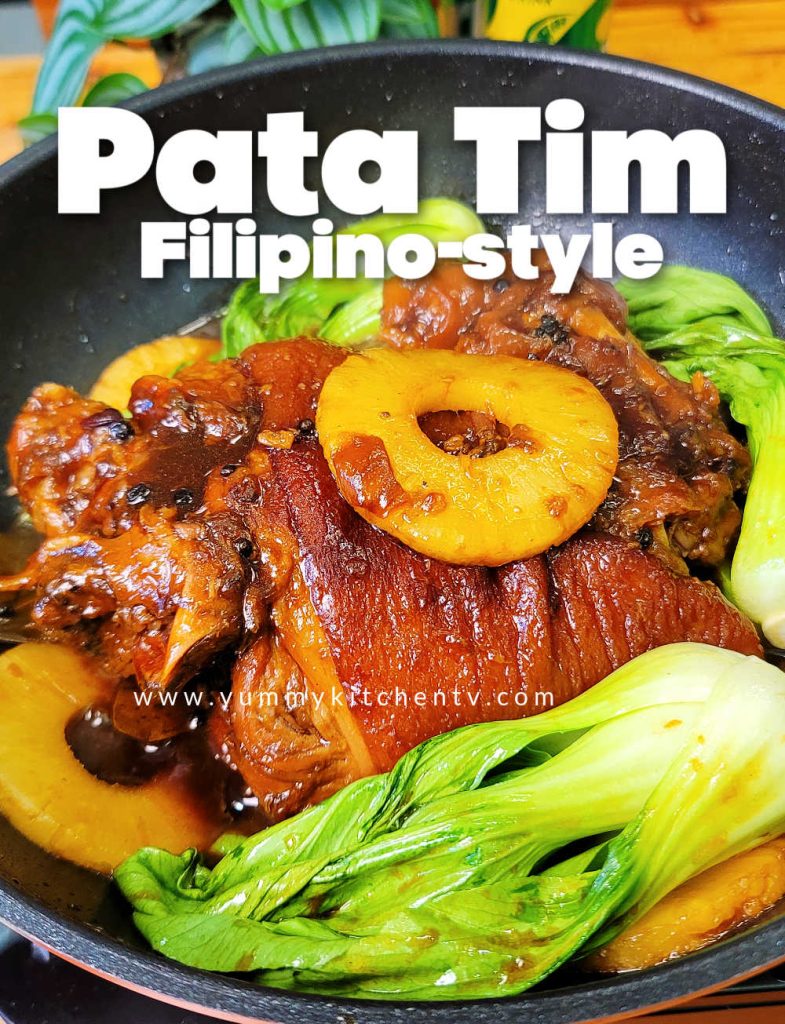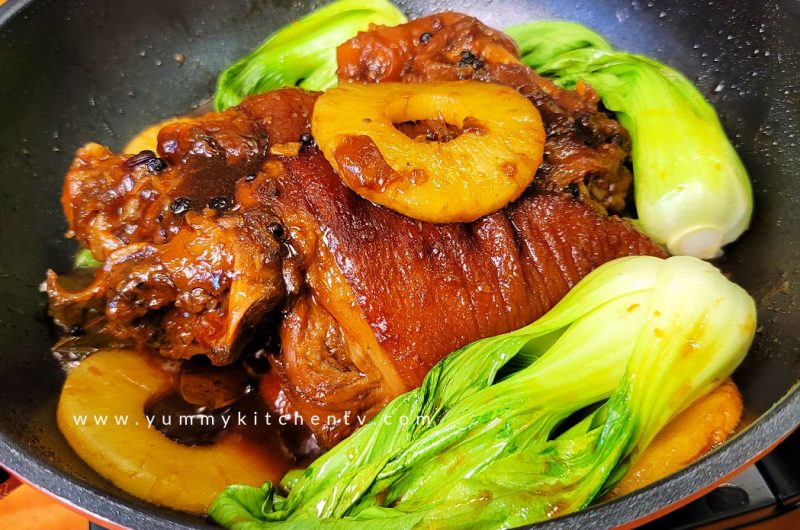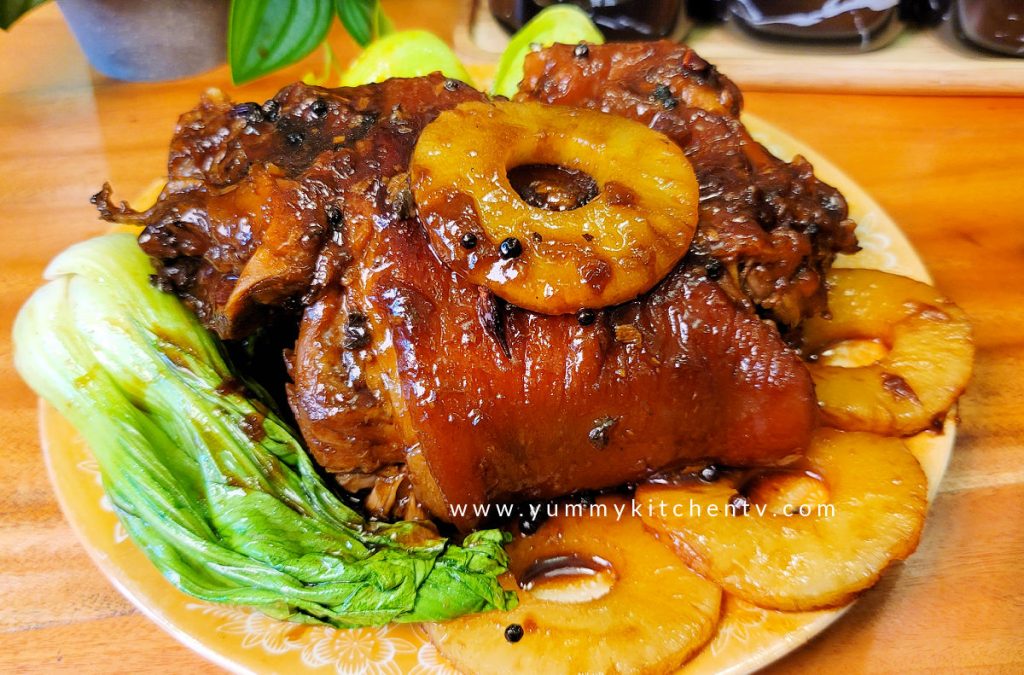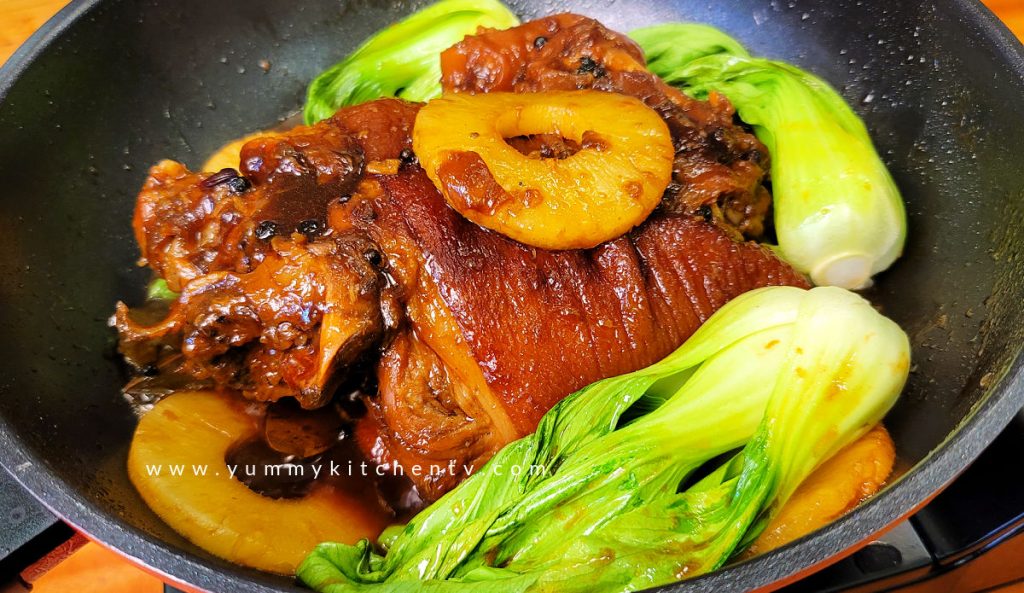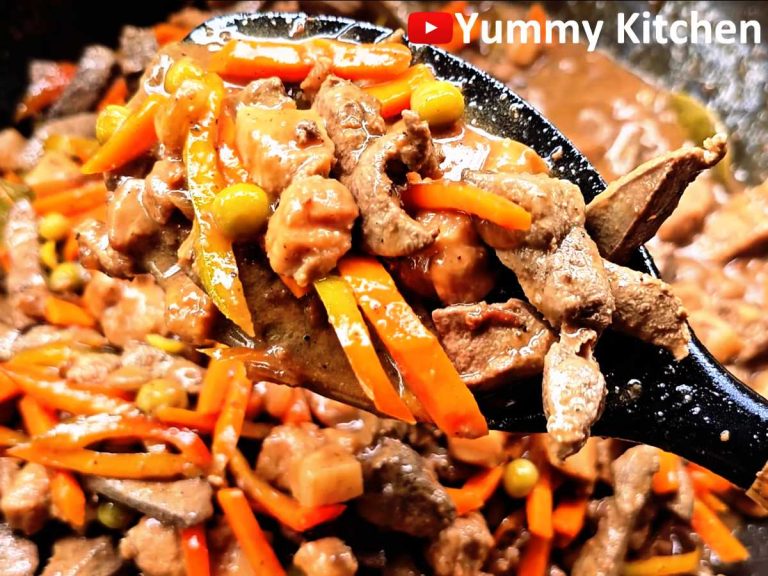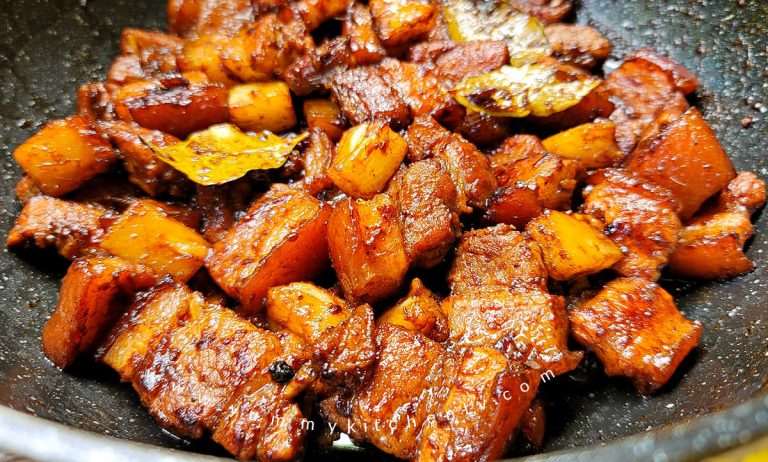Pata Tim Recipe
Pata tim is a Filipino pork dish made by braising a whole pork hock in a sweet and savory sauce.This dish is adapted from Chinese cuisine, and the distinctive flavor from the star anise gives it a highly prominent taste. With its unique presentation, pata tim is considered one of the top dishes that takes center stage on the table.
Ingredients:
- 1 piece pork pata
- 5 cloves of garlic
- 1 large onion
- 1 tablespoon whole peppercorns
- 2 pieces star anise
- 3 pieces dried bay leaves
- 1 can (277 g) pineapple slices
- ½ cup soy sauce
- 3 tablespoons oyster sauce
- 2 tablespoons sugar
- 2 – 3 cups Sprite (or 7up)
- water (to cook the pork)
- 3 bunches bok choy
Directions:
- Pour a lot of water in a pot and parboil the pata for a few minutes. This is optional but recommended to remove the raw smell and impurities. After a few minutes, discard the water and wash the pork pata.
- Heat some oil in a deep pan. Sear the pata until the skin is brown. You might need to flip the pata for a few times. Set aside.
- Using the same pan, add more oil and then saute the onions and garlic for a few minutes until light brown. Add the peppercorns, dried bay leaves, star anise and saute for just a few seconds.
- Add the seared pata back to the pan. Pour the Sprite, and then add the soy sauce, ketchup, oyster sauce, sugar and the syrup from the pineapple slices. Mix gently. Cover the pot and let this simmer for 30 minutes using low medium heat. After 30 minutes, flip the pata to cook the other side. Simmer for another 45 minutes using low heat.
- Do the fork test to check if it is tender. If not, add more water and then simmer again using low heat until the pork is soft and fully cooked.
- Once tender, add the pineapple slices in the sauce. Baste the pata with the sauce to absorb more flavors. Continue simmering until the sauce is greatly reduced.
- Then, add the bok choy. Cover the pan for 3 – 5 minutes until the leaves are soft and cooked. Turn the heat off.
- Transfer the pork pata tim to a large serving plate. Enjoy this with a big bowl of hot steaming rice or noodles. Yum!
PATA TIM (Filipino-style) RECIPE
PATA TIM (Filipino-style)
Let me start my section by sharing that I was afraid of looking at pata tim when I was a child. We all know that the real pata tim includes literally the whole pork leg, up until the hoofs. I got afraid on the hoofs/nails since I always feel that the pata tim will kick me anytime soon.
(Quick story: I had a wild experience when I went to a piggery when I was really little. A large pig kicked me using his hind leg.. and then I never went near a pig ever again.)
I consider Pata Tim as the Chinese version of ham. It almost have the same characteristics with the Western version of the ham. Both are sweet, savoury, and served BIG. The word pata tim came from the root word which means “black pork hock”, which is how this dish looks after being simmered slowly in a soy sauce based broth.
Aside from pata tim, I cannot also eat crispy pata before due to the same reason. My mom would usually just get me some meat off the bone so I don’t really have to go near the whole pata. Another strategy my mom did was to chop the pata into large chunks so that I wouldn’t imagine the whole picture.
Congratulations to me, I had overcame my fear with pork leg as time went by. As a person with a sweet tooth, my love for sweets does not only apply to desserts, but also with savoury dishes. Pata tim became one of my faves after asado (which also uses star anise). I have been alternating crispy pata to pata tim, as the latter would not need any sauces anymore.
No need to go to Binondo to have a taste of the legit pata tim. If you wanna know how to make pata tim at home, read and follow the simple recipe below!
HOW TO MAKE PATA TIM
Preparing pata tim at home might seem intimidating for some, but once you have the right deep pot at home, you can definitely make this gigantic dish perfectly. Make sure you are not hungry enough when you cook this, as the total cooking time may reach up to 2 hours and 30 minutes. Im using a regular pot when cooking this recipe, but you can reduce the cooking time if you use a pressure cooker.
This recipe uses a whole pork pata but optionally, you can chop them into smaller sizes for to be more manageable. But if you want the pata tim to be the star of the table, then better go with the whole piece.
I start my pata tim by parboiling my pata. Parboiling is simply partially boiling meat in water. Although this first step is actually optional, doing this will remove impurities from the meat (appears as white scum or foam in the water) and remove the raw smell of the pork. Keep in mind that this step do not aim to cook the meat.
The pata is now ready. The next thing to do is to sear the skin of the pata. Searing adds flavor to the crust of the meat. Unlike those cooking videos where hot oil is poured over the pork (usually seen in crispy pata videos), searing our pata is simply frying them in shallow oil just so the skin will partially pop. Even the searing of the meat will take plenty of time since we want to cover all sides.
To fully cook our giant pata, we need a deep pot. Im using a regular pot which is around 12 inches height, to make sure that the broth we will be making will fully cover the pata. While the pata is naturally meaty and savoury, our local spices like peppercorns, star anise and dahon ng laurel will truly give you the pata tim flavor. Add a lot of water to the pot, and then the rest of the seasonings. Aside from sugar, I added some Sprite (lemon soda) to the broth for an added fruity hint and to also help tenderize the meat quicker.
From time to time, check if the meat is tender. You can easily check this by doing the fork test or you can use a kitchen thermometer to check the internal temperature of the meat, especially when we are dealing with a thick one. Once the broth has been sipped in, there is a large chance that the pata is almost ready. Just wait for the sauce to thicken and then it’s done!
For some contrast in colors, I usually add some bok choy on the sides of the meat to make it look more fresh and appetizing.
I really love my pata tim alongside my chow fried rice and noodles. Yum!
Pata Tim (Filipino-style) Recipe in Tagalog
Mga Sangkap:
- 1 pork pata
- 5 butil ng bawang (hiniwa)
- 1 malaking sibuyas (hiniwa)
- 1 kutsarang pamintang buo
- 2 pirasong star anise
- 3 pirasong dahon ng laurel
- 1 lata (277 g) pineapple slices
- ½ tasang toyo
- 3 kutsarang oyster sauce
- 2 kutsarang asukal
- 2 – 3 tasang Sprite (o 7up)
- tubig (para maluto ang baboy)
- 3 bugkos ng bok choy
Paano Lutuin:
- Magpakulo ng maraming tubig sa kawali. Pakuluan ang pata ng ilang minuto. Optional step ito pero recommended para matanggal ang hilaw na amoy ng baboy pati ang impurities nito. Pagkatapos ng ilang minuto, alisin na ito sa tubig at hugasan ang pork pata.
- Magpainit ng maraming mantika sa kawali. Iprito ang pata hanggang maging brown ang balat. Kailangan mong baliktarin ng ilang beses and pata para maluto lahat ng side nito. Isantabi.
- Gamit ang parehong kawali, dagdagan ang mantika nito saka igisa ang sibuyas at bawang ng ilang minuto hanggang maging light brown. Sunod na ilagay and buong paminta, dahon ng laurel at star anise. Igisa ang mga ito ng konti.
- Ibalik ang pritong pata sa kawali. Ibuho ang Sprite at ilagay na ang toyo, ketchup, oyster sauce, asukal at ang sabaw ng pineapple slices. Haluin ito ng konti bago takpan ang kawali. Hayaan ito maluto ng 30 minuto gamit ang mahinang katamtamang apoy. Pagkatapos ng 30 minuto, baliktarin ang pata at lutuin ang kabilang side ng 45 minuto gamit ang mahinang apoy.
- Tingnan kung malambot na ang pata. Kung hindi pa, magdagdag ng tubig at ituloy lang ang pagluluto gamit ang mahinang apoy hanggang lumambot ito.
- Kapag malambot na, ilagay ang pineapple slices sa sauce. Buhus buhosan ng sauce ang pata para mas pumasok ang linamnam. Hayaan itong maluto hanggang halos maiga na ang sabaw.
- Ilagay ang bok choy. Takpan ang kawali ng 3 – 5 minuto hanggang lumambot ito. Patayin ang apoy.
- Ilipat ang pork pata tim sa malaking serving plate. Ihain ito kasama ng maraming kanin o noodles. Yum!


